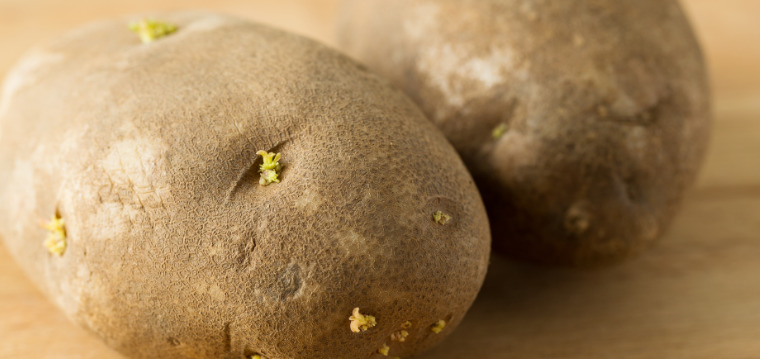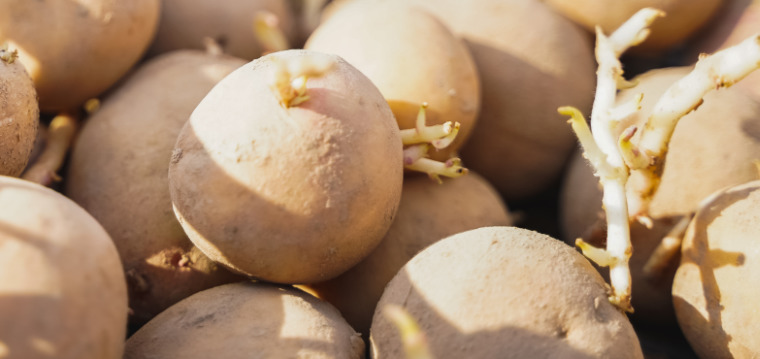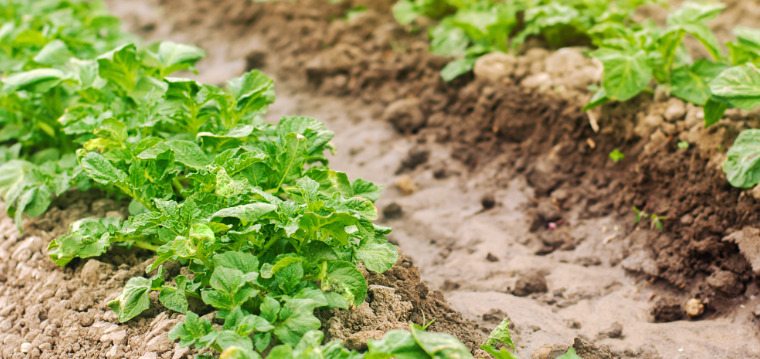Do you plant potatoes in your garden? Or, are you looking to grow some new vegetables this year? If so, then you might have heard about chitting and you’re here because you would like to know more…
Thankfully, you’ve come to the right place! Even though the process of chitting is not essential to growing a crop of potatoes, it could make your batch grow faster if done correctly.
Now, you might be wondering, when is the best time to chit potatoes? What do you need for chitting potatoes? And, is it worth all the effort? If you’re asking yourself these questions then this article will give you everything you need to know about potato chitting and why you should try it.
Keep reading to find out more!
What Is Potato Chitting?
Before you decide to chit your potatoes you’ll need to know what potato chitting actually means…
Potato chitting refers to the process of inducing potato sprouts to grow before they are planted in the ground. Think of it like this, it’s the secret spell to getting a head start in the growing process and reduces the amount of time you have to wait until you can harvest your crop.

Are you someone who gets impatient waiting for your vegetables to grow? Then, this could be the solution to all your problems!
Not only does it make the growing process quicker, but it can also improve the quality of your harvest. Therefore, there are many benefits to this method that we’ll talk more about later on in this article.
A Guide to Potato Chitting
A great gardening tip for planting potato seeds is to buy them early. This will ensure that you have the variety you want and you can pick from a whole collection before they are sold out. Once you decide to chit your potatoes, you’ll need to think carefully about when you begin this process.
So, when do you chit potatoes?

When to Chit Potatoes
As a general rule, your potato seeds should be chitted around 6 weeks before you plant the seeds. For example, if you begin the chitting process in February the potato should be ready to plant in March/April.
However, this will depend on where you live and the weather conditions. Some areas could experience late frost which could affect potato chitting. As long as the soil temperature is around 6-10 degrees then you can begin chitting!
How to Chit Potatoes
Once you’ve chosen a suitable date to begin chitting your potatoes you’ll need a few things to get started. For instance, you’ll need a seed tray or egg box to place the seeds. In addition to this, you’ll also need adequate light and heat.
- Prepare Seed Potatoes
First, you’ll need to gather a bag of seed potatoes. It’s always a good idea to check them to see if they’re mouldy or damaged. Then, you’ll have to arrange your seed tray or egg box near a well-lit area and place one seed potato in each section.
When you’re placing the seeds into the tray you’ll have to make sure that the blunt end with the most “eyes” is facing up towards the sky. This is the area where the sprouts and shoots will appear. The other end, the heel of the potato, should be at the bottom.
However, if you don’t have a spare egg box or seed tray, you can also use an old container and create dividers. This can be easily done with DIY methods so you don’t need to worry about buying anything new.
Just remember to leave a little room between the seeds to allow enough air to circulate during cheating. Otherwise, mould could start growing and you might end up with dampness.
Now, you’re ready to start the chitting process!
- Label the Potato Seeds
To help you keep organised, it’s useful to label your potato seeds. You should write down the name of the potato variety and the date it was placed in the box. This will help you keep track of time so you know when they’re ready for planting!
In terms of light exposure, an area near a windowsill or outside sheltered space is ideal for potato chitting. The temperature should be moderate so as long as it’s not too warm or cold then it’s perfect. Ideally, you want a location that’s 7-12 degrees.
If you think your seeds are getting too much light, you’ll be able to tell by looking at them. If the sprouts are long and thin then it could be a sign that there isn’t enough light. You want the sprouts to be short and deep green in colour.
So, as long as the sprouts are short and green in colour, you know you’re doing it right!
- Remove the Shoots
Do you want to grow large potatoes? Or, are you looking to harvest small potatoes? Depending on which option you’d like, that will determine when you should remove the shoots. For larger potatoes, you want to remove the shoots when they reach 1-2cm high.
As long as the shoots are long they will grow large potatoes, so you should remove them if you want a smaller batch.
- Caring for Your Seeds
Of course, with any planting journey, you want to check in on your seeds regularly. You want to keep an eye on the development of the shoots to make sure that they are getting enough light and the correct temperature.
If they begin moulding or feel damp you might need to adjust the environment and move their location. Regardless, it’s good to check them every few days just to be on the safe side!
- Watch Your Potatoes Grow
After you’ve waited 6 weeks, you’ll be able to plant your potatoes. The way you plant your potatoes will also vary from person to person. Are you looking to crop a large batch of potatoes? Or, do you want to cook your own potatoes for salads and side dishes?
Larger crops grow better planted directly in the ground, whereas baby potatoes thrive when planted in containers. However, if you don’t have a container you can also grow them in an old compost bag.
Soil is another important part of the planting process. In other words, the richer the soil the better. Plus, a handy tip is to add a layer of newspaper to soak up excess moisture.
Then, all you need to do is wait for the magic to happen!

Is Potato Chitting Worth It?
Now, if you’ve made it this far in the article, you’re probably already planning how to chit your potato seeds…
But, if you need a little more convincing, let’s take a look at a few pros and cons of this gardening method.
Pros
The first crop of potatoes is normally planted in the middle of March or the middle of April. Although, because the soil at this time of year tends to be wet and cold due to the season, chitting your potatoes could give them a head start over the ones that haven’t been chitted.
This is particularly useful if you sell potatoes and want to beat competitors in the market. But, it’s also great for people who want to enjoy potatoes early in the year!
Therefore, here are the three main reasons you should chit your potatoes:
- Early crop
- Higher quality
- Fun to grow
Cons
Even though there are benefits to chitting your potato, there are also a few downsides…
For example, it takes a lot of time and effort. You have to set up the chitting potatoes, check on them regularly, and prepare time to plant them afterwards. For some people, this might be too much effort, but it could be worth it if you want your potatoes sooner!
So, to help you make your decision, here are three cons of chitting potatoes:
- Time-consuming
- Extra space required
- Not necessary
Hopefully, now you have all the information you need to decide whether or not you want to chit your potatoes. Without a doubt, it can produce an earlier crop, but it can also take up a lot of time. Ultimately, the decision is all yours and will depend on your individual situation.
No matter what you decide, it’s a wonderful method to keep in mind for the future!
Happy Planting!